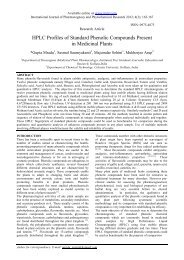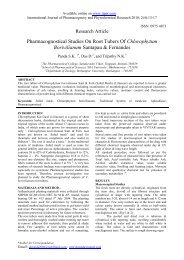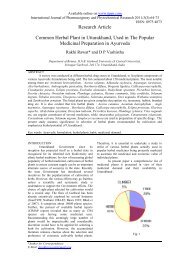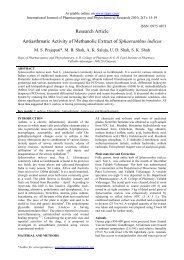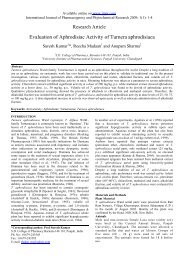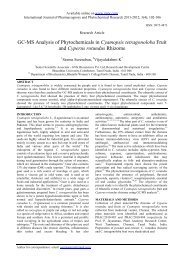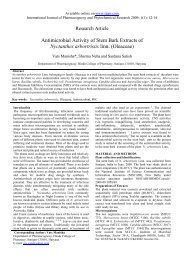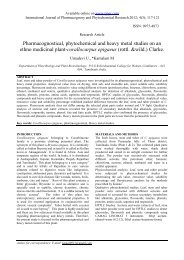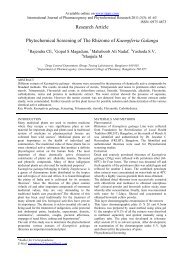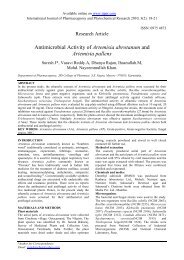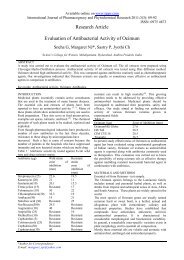Full Text PDF - International Journal of Pharmacognosy and ...
Full Text PDF - International Journal of Pharmacognosy and ...
Full Text PDF - International Journal of Pharmacognosy and ...
Create successful ePaper yourself
Turn your PDF publications into a flip-book with our unique Google optimized e-Paper software.
Available online on www.ijppr.com<br />
<strong>International</strong> <strong>Journal</strong> <strong>of</strong> <strong>Pharmacognosy</strong> <strong>and</strong> Phytochemical Research 2012-13; 4(4); 213-218<br />
Research Article<br />
ISSN: 0975-4873<br />
Evaluation <strong>of</strong> Anti-Obesity Activity <strong>of</strong> Lantana camara Var Linn. by<br />
Progesterone Induced Obesity on Albino Mice<br />
* 1 Rohit Gundamaraju, 1 Sartaj Banu Mulaplli, 2 Dr.Ramesh.C.<br />
Department <strong>of</strong> Pharmacolgy , Malla Reddy Institute <strong>of</strong> Pharmaceutical Sciences , Maisammagud , Dhulapally(Post via<br />
Hakimpet) ,Secunderabad (500014), AP,India.<br />
2<br />
GSN Pharmaceuticals Pvt .Ltd., Rajeev G<strong>and</strong>hi Nagar, Kukatpally, Hyderabad (500072),AP,India.<br />
ABSTRACT<br />
The anti-obesic activity <strong>of</strong> Lantana camara was studied on progesterone induced models <strong>of</strong> hyperlipedemia in mice.<br />
Hyperlipidemia condition established by progesterone, which changed various parameters in the body . An increase in<br />
food consumption <strong>and</strong> water consumption usually accompanies the body weight gain, which is the characteristic nature<br />
<strong>of</strong> progesterone stimulation. Increased consumption <strong>of</strong> food <strong>and</strong> water generally leads to elevated parameters like<br />
LDL,VLDL, serum cholesterol etc. Accumulation <strong>of</strong> fat in areas like inguinal, epididymal , neck etc. was observed .<br />
Ethanobotanical knowledge <strong>of</strong> medicinal plants is one <strong>of</strong> the most prominent source <strong>of</strong> new drugs <strong>and</strong> has shown<br />
potential results for treatment <strong>of</strong> obesity. Preliminary phytochemical analysis <strong>of</strong> Lantana camara revealed the presence<br />
<strong>of</strong> phyto constituents such as steroids , flavinoids , alkaloids, etc.<br />
Keywords: Adipocyte, progesterone, Obesity<br />
INTRODUCTION<br />
Obesity is a chronic metabolic disorder caused by an<br />
imbalance between energy intake <strong>and</strong> expenditure. Over<br />
weight <strong>and</strong> obesity are defined as abnormal or excessive<br />
fat accumulation that presents a risk to health. Obesity is<br />
one <strong>of</strong> the greatest health threats <strong>of</strong> this century. Chronic<br />
obesity is a problem <strong>of</strong> epidemic proportions, <strong>and</strong> is<br />
rapidly increasing in prevalence in both the West <strong>and</strong> the<br />
Asia-Pacific region¹ ˉ² which has an important impact<br />
on life style-related diseases such as coronary heart<br />
disease, dyslipidemia, glucose intolerance, diabetics,<br />
hypertension <strong>and</strong> some cancers³ . Several factors,<br />
including lack <strong>of</strong> exercise, sedentary lifestyles <strong>and</strong> the<br />
consumption <strong>of</strong> energy rich diets are contributory to the<br />
etiology <strong>of</strong> obesity⁴. Despite the urgent need for safe <strong>and</strong><br />
efficient therapeutics <strong>and</strong> the potential size <strong>of</strong> the market<br />
for anti-obesity drugs, the current status for the<br />
development <strong>of</strong> such drugs are still unsatisfactory ⁵.<br />
Some edible medicinal plants have been used as dietary<br />
supplements for body-weight management <strong>and</strong> control in<br />
many countries⁶ˉ⁷ .<br />
In the literature survey, it was found that flavonoids,<br />
sterols, tannins, <strong>and</strong> alkaloids have shown promising<br />
effects to tackle obesity by various mechanisms, Lantana<br />
camara whole plant has shown the presence <strong>of</strong> sterols,<br />
triterpenoids, flavonoids alkaloids <strong>and</strong> saponins, <strong>and</strong><br />
others in the extracts. Moreover, traditional Indian<br />
medicine also claims for its antiobesity activity. With this<br />
back ground, this plant has been selected for its<br />
phytochemical analysis <strong>and</strong> screening <strong>of</strong> its antiobesity<br />
activity against progesterone-induced obesity in female<br />
mice. The neuroactive steroid, progesterone is a female<br />
reproductive hormone. Its level increases during the later<br />
phase <strong>of</strong> the menstrual cycle <strong>and</strong> controls the secretory<br />
phase <strong>of</strong> the endometrium. Substantial evidence links<br />
progesterone excess in pathophysiology <strong>of</strong> eating <strong>and</strong><br />
affective disorders. Some reports suggest the use <strong>of</strong><br />
progesterone-containing preparations as contraceptive or<br />
for the hormone replacement therapy to cause sufficient<br />
weight gain by causing hyperphagia <strong>and</strong> increased fat<br />
deposition in the body⁸. Reports also suggest that<br />
progesterone can produce these effects by inducing<br />
myriad <strong>of</strong> neurotransmitter changes <strong>of</strong> which alterations<br />
<strong>of</strong> serotonin level can have important. With this setting<br />
neuroactive to induce obesity in female mice has been<br />
chosen.<br />
MATERIALS AND METHODS<br />
Collection <strong>of</strong> plant material: Lantana camara whole plants<br />
materials were collected from Tirupathi . The plant<br />
authentication was done by Department <strong>of</strong> Botany,Sri<br />
Venkateshwara University , Tirupathi dist. Chittoor ,<br />
Andhra Pradesh, <strong>and</strong> the voucher was preserved.<br />
Preparation <strong>of</strong> the extract: Leaves <strong>of</strong> Lantana camara<br />
were shade dried at room temperature for 2-3 days. These<br />
dried leaves were then powdered in a mixture. The<br />
extraction process was done in a Soxhlet extractor. The<br />
fine powder (100 grams ) was suspended in (200 ml) <strong>of</strong><br />
methanol for 24 hours at room temperature. After<br />
extraction , the solvent was evaporated by rotary<br />
evaporator <strong>and</strong> the residue was dried.⁹<br />
Experimental animals: Female albino mice (20–25 g)<br />
were used in this study. Mice bred at GSN<br />
Pharmaceuticals PVT.LTD animal house were used in<br />
this experiment. Animals were housed in a st<strong>and</strong>ard<br />
controlled animal care facility in cages (5 mice/cage).<br />
Author for correspondence: E-mail: rohit.gundamaraju@gmail.com
Rohit Gundamaraju et,al./ Evaluation <strong>of</strong> Anti-Obesity…<br />
The following table consists <strong>of</strong> the data derived from the results <strong>of</strong> the histopathology <strong>of</strong> the various slides consisting<br />
<strong>of</strong> the organs(liver) sections <strong>of</strong> various groups. The table consists <strong>of</strong> the inducing agent, size <strong>of</strong> the organs, changes<br />
observed, <strong>and</strong> conclusions drawn.<br />
S.N GROUP SIZE COLOR INFERENCE CONCLUSION<br />
O<br />
1. INDUCING<br />
AGENT<br />
Slight<br />
increase<br />
normal Mild fatty change The liver is prone to fatty diet,as<br />
there is increase in the fat cells.<br />
2. INDUCING<br />
AGENT +<br />
TREATED<br />
DRUG<br />
EXTRACT<br />
3. INDUCING<br />
AGENT +<br />
TREATED<br />
DRUG<br />
EXTRACT(D<br />
OUBLE<br />
DOSE)<br />
4. INDUCING<br />
AGENT +<br />
STANDARD<br />
normal normal Positive necrosis,focal<br />
necrosis<br />
<strong>of</strong><br />
hepatocytes,swelling found<br />
normal normal Focal necrosis,swelling <strong>of</strong><br />
hepatocytes with change in<br />
the cells <strong>and</strong> degenation in<br />
some places,<br />
normal normal Mild necrosis found. Less<br />
extent when compared to 2 nd<br />
<strong>and</strong> 3 rd conditions.<br />
DRUG<br />
The animals were maintained in a temperature-controlled<br />
room (22°C–25°C, 45% humidity) on a 12:12 h dark:light<br />
cycle. The animals were maintained under st<strong>and</strong>ard<br />
nutritional <strong>and</strong> environmental conditions throughout the<br />
experiment. All the experiments were carried out between<br />
9:00–16:00 hours at ambient temperature. Nations<br />
CPCSEA guidelines were strictly followed <strong>and</strong> all the<br />
studies were approved by the Institutional Animal Ethics<br />
Committee (IAEC).<br />
Preliminary Phytochemical analysis: The methanol<br />
extract <strong>of</strong> Lantana camara was subjected to preliminary<br />
phytochemical analysis to assess the presence <strong>of</strong> various<br />
phytoconstituents; it revealed the presence <strong>of</strong> flavonoids,<br />
alkaloids <strong>and</strong> glycosides. All these tests were performed<br />
at GSN Pharmaceuticals PVT.LTD.<br />
Induction <strong>of</strong> progesterone-induced obesity: Progesterone<br />
vial contents were dissolved in arachis oil <strong>and</strong> a dose <strong>of</strong><br />
10 mg/kg was administered subcutaneously in the dorsal<br />
neck region to mice for 28 days, control group received<br />
the vehicle. All drugs were given at a dose <strong>of</strong> 0.4 mL/100<br />
g body weight. The test drugs were injected 30 min<br />
before progesterone administration.¹⁰<br />
Test drug preparation: the extract <strong>and</strong> st<strong>and</strong>ard<br />
sibutramine are soluble in water, so distilled water was<br />
used as media to dissolve. For progesterone, arachis oil<br />
was used as a vehicle <strong>and</strong> diluent for appropriate doses.<br />
All the drug concentrations were prepared freshly just<br />
before administration. All the test drugs, including the<br />
st<strong>and</strong>ard were given by oral gavages by p.o. route.<br />
EVALUATION<br />
Body weight: The body weights <strong>of</strong> mice (g) were<br />
recorded every week for 28 days in each group just before<br />
dosing by using precision balance <strong>of</strong> 10 mg sensitivity.<br />
Extract found to show effect on<br />
liver.fatty change is abscent ,drug<br />
extract found to show its action on<br />
the fatty liver.<br />
Extract found to show its action on<br />
liver,fatty change is abscent,drug<br />
extract found to show its action on<br />
the fatty liver<br />
Action <strong>of</strong> the drug is mild when<br />
compared to 2 nd <strong>and</strong> 3 rd<br />
conditions,drug having mild<br />
properties<br />
Biochemical parameters: Preparation <strong>of</strong> serum: On day<br />
29 <strong>of</strong> the study, that is, after the last test drug<br />
administration, the mice were anesthetized under light<br />
ether anesthesia <strong>and</strong> blood for serum preparation was<br />
collected by retro orbital puncture, using 10 μL×20 mm<br />
(L) × 0.8 mm (2R) glass capillary into sterile EDTAcoated<br />
tube (3 mg/mL) for the estimation. Blood was kept<br />
in wet ice for 30 min, centrifuged for 5 min at 4000 rpm<br />
at 4°C (REMIMAK, Remi Instruments Ltd, Mumbai,<br />
India) <strong>and</strong> plasma was aspirated out for the analysis <strong>of</strong><br />
lipid pr<strong>of</strong>ile. The serum was stored in the refrigerator for<br />
the analysis <strong>of</strong> biochemical parameters. All analyses on<br />
serum were completed within 24 h <strong>of</strong> sample collection.<br />
Serum samples were analysed at AZ<br />
Laboratory(Hyderabad).<br />
STATISTICAL ANALYSIS<br />
The results are expressed as mean±SEM. Comparisons<br />
between the treatment groups <strong>and</strong> positive control;<br />
positive control <strong>and</strong> control were performed by one-way<br />
analysis <strong>of</strong> variance (ANOVA) followed by Dunnett's<br />
test. In all the tests the criterion for statistical significance<br />
was P
Rohit Gundamaraju et,al./ Evaluation <strong>of</strong> Anti-Obesity…<br />
Triglycerides; HDL-C – High density lipoprotein<br />
cholesterol; LDL-C – Low density lipoprotein<br />
cholesterol; VLDL – Very low density lipoprotein<br />
cholesterol; SGOT – Serum glutamate oxaloacetate<br />
transaminase; SGPT – Serum glutamate pyruvate<br />
transaminase; Progesterone induced group have shown<br />
significant increase in TG, LDL-C, VLD-C, SGOT <strong>and</strong><br />
SGPT level <strong>and</strong> reduction in HDL-C level compared<br />
to normal control mice. Treatment with MECP 200 <strong>and</strong><br />
400 mg/kg have shown significant increase in HDL-C<br />
<strong>and</strong> reduction in other biochemical parameters.<br />
Sibutramine have shown most significant results by<br />
increasing in HDL-C level <strong>and</strong> reduction in TG, LDL-C,<br />
VLDL-C, SGOT <strong>and</strong> SGPT level compared with<br />
progesterone induced <strong>and</strong> any Lantana camara treated<br />
group. *Comparison <strong>of</strong> test <strong>and</strong> disease control with<br />
normal control; #Comparison test with disease control<br />
DISCUSSION<br />
Obesity is a medical condition in which excess body fat<br />
has accumulated to the extent that it may have an adverse<br />
effect on health, leading to reduced life expectancy <strong>and</strong>/or<br />
increased health problems¹¹. Body mass index (BMI), a<br />
measurement which compares weight <strong>and</strong> height, defines<br />
people as over weight (pre-obese) if their BMI is between<br />
25 <strong>and</strong> 30 kg/m2, <strong>and</strong> obese when it is greater than<br />
30 kg/m2.<br />
Obesity increases the likelihood <strong>of</strong> various diseases ,<br />
The following are the microscopic images <strong>of</strong> the histopathology <strong>of</strong> various groups <strong>of</strong> liver samples:<br />
Progesterone induced: The presence <strong>of</strong> the fatty change in the liver cells shows that the progesterone has successfully<br />
responsible for the induction <strong>of</strong> obesity <strong>and</strong> the occurance <strong>of</strong> fat globules<br />
Fatty change in hepatocytes<br />
MELc 200mg/kg+pro: The methanolic extract <strong>of</strong> 200mg <strong>of</strong><br />
Lantana camara brought changes like focal necrosis, <strong>and</strong><br />
slight hepato toxicity, which proves that there is action opf<br />
the drug <strong>and</strong> absence <strong>of</strong> fat globules.<br />
Fatty change in hepatocytes<br />
Swelling <strong>of</strong> hepatocytes focal Necrosis +<br />
Swelling with focal necrosis<br />
MELc 400mg+pro: In this extract, there is significant <strong>and</strong><br />
increased focal necrosis <strong>and</strong> total absence <strong>of</strong> fat globules<br />
<strong>and</strong> this extract shows perfect decrease in the fat cells<br />
which were induced by progesterone.<br />
Focal necrosis<br />
Page215<br />
IJPPR, Vol-4, Issue 4, December 2012- February 2013, 213-218
Rohit Gundamaraju et,al./ Evaluation <strong>of</strong> Anti-Obesity…<br />
Swelling <strong>of</strong> hepatocytes<br />
Sibutramine 10mg/kg+pro: In this case there was mild<br />
necrosis found.<br />
Swelling <strong>of</strong> hepatocytes<br />
Mild necrosis–central vein<br />
Few damaged cells<br />
Treatment<br />
Glucose<br />
(mg/dl)<br />
TC<br />
(mg/dl)<br />
TG<br />
(mg/dl<br />
HDL-C<br />
(mg/dl)<br />
LDL-C<br />
(mg/dl)<br />
VLDL-C<br />
(mg/dl)<br />
SGOT<br />
(IU/L)<br />
SGPT (IU/L)<br />
Control<br />
(Vegetable<br />
oil)<br />
Progesteron<br />
e<br />
MELc (200<br />
mg/kg)<br />
+ Pro<br />
MELc (400<br />
mg/kg)<br />
+ Pro<br />
Sibutramine<br />
10mg/kg+pro<br />
135.67±1<br />
4.01<br />
188.43±1<br />
0.19<br />
144.35±<br />
9.65<br />
118.3±5.<br />
69<br />
136.33±<br />
6.66*<br />
100.16±1<br />
6.65<br />
137.17±<br />
11.37<br />
143.11±1<br />
4.62<br />
126.01±7<br />
.67<br />
66.4±4.<br />
74**<br />
79.905±<br />
7.29<br />
147.15±1<br />
3.23<br />
113.43±<br />
9.28<br />
94.8±6.1<br />
1*<br />
57.37±5.<br />
95**<br />
26.06±0.5<br />
55<br />
19.28±0.7<br />
13**<br />
21.31±1.02<br />
4**<br />
26.89±1.0<br />
45 ##<br />
57.29±1<br />
6.61<br />
84.45±1<br />
3.01<br />
103.18±1<br />
4.63<br />
80.165±<br />
8.00<br />
30.97±0.8 30.97±0<br />
41** ## .841 #<br />
15.81±1.4<br />
57<br />
29.43±2.6<br />
46**<br />
22.686±1.<br />
85<br />
18.96±1.2<br />
2<br />
11.47±1.1<br />
8 ##<br />
137.23±<br />
6.51<br />
153.68±<br />
11.77<br />
144.2±1<br />
4.04<br />
109.1±21.<br />
06<br />
114.7±12<br />
.16<br />
68.88±6.99<br />
97.25±9.31<br />
141.58±14.54<br />
107.03±18.35<br />
Values are expressed as mean ± SEM. Levels <strong>of</strong> significance- Group II compared with Group I,III <strong>and</strong> IV. **p_0.01 <strong>and</strong><br />
***p_0.001.<br />
8<br />
0.<br />
9<br />
7<br />
±<br />
7.<br />
5<br />
6<br />
particularly heart disease , type2 diabetis, obstructive<br />
sleep apnea, certain types <strong>of</strong> cancer, <strong>and</strong> osteoarthritis.<br />
Obesity is most commonly caused by a combination <strong>of</strong><br />
excessive food energy intake, lack <strong>of</strong> physical activity,<br />
<strong>and</strong> genetic susceptibility, although a few cases are<br />
caused primarily by genes, endocrine disorders,<br />
medications or psychiatric illness. Evidence to support<br />
the view that some obese people eat little yet gain weight<br />
due to a slow metabolism is limited; on average obese<br />
people have a greater energy expenditure than their thin<br />
counterparts due to the energy required to maintain an<br />
increased body mass.¹²<br />
In medical sciences many attempts have been made to<br />
correct this disorder, producing a number <strong>of</strong> agents<br />
including fibrates , sibutramine, <strong>and</strong> drugs like orlistat but<br />
unfortunately they are teamed with lots <strong>of</strong> adverse<br />
effects¹³ˉ¹⁴. Due to various reasons like cost factor,<br />
adverse effects etc.. the essentiality <strong>of</strong> devolopment <strong>of</strong><br />
herbal formulations are been enhanced. Due to this effort,<br />
herbal formulations may be regarded as an excellent<br />
Page216<br />
IJPPR, Vol-4, Issue 4, December 2012- February 2013, 213-218
Rohit Gundamaraju et,al./ Evaluation <strong>of</strong> Anti-Obesity…<br />
alternative strategy for devoloping future effective , <strong>and</strong><br />
safe anti-obesity drugs. A variety <strong>of</strong> natural products<br />
including crude extracts <strong>and</strong> isolated compounds from<br />
plants , can add up the effort to body weight reduction<br />
<strong>and</strong> prevent diet induced obesity . Therefore they have<br />
been widely used in treating obesity.¹⁵ˉ¹⁶<br />
Several plant extracts in traditional medicine are been<br />
used to treat obesity with deleted adverse effects. Plants<br />
like Camellia sinensis(L), Citrus aurantium L. , Salix<br />
matsudana Koidzumi, Nelumbo nucifera, Hibiscus<br />
sabdariffa L. are been used traditionally.¹⁷ˉ¹⁸<br />
Lantana camara Linn.(Verbenaceae) is a plant which is<br />
commonly known as wild sage- notorious weed. It is an<br />
annual plant which grows upto 1.2-2.4 m high <strong>and</strong> has<br />
various uses in folklore medicine in many parts <strong>of</strong> the<br />
world¹⁹ˉ²⁰. The leaves are reported to be useful in the<br />
treatment <strong>of</strong> urinary diseases, tetanus, malaria, epilepsy.<br />
They are also used as carminatives <strong>and</strong> antipasmodics.<br />
The plant has also been found to have hypoglycemic<br />
activity. This plant was also named as wonder drug in<br />
various places.<br />
In our study, initial phytochemical analysis was carried<br />
out <strong>and</strong> it was evident that Lantana camara contains<br />
alkaloids, flavanoids, tanins, <strong>and</strong> glycosides. Based on<br />
this phytochemical screening <strong>and</strong> ethanobotanical claims<br />
this plant was selected to carry out this study. And also it<br />
has been reported that chemical constituents like<br />
flavanoids , alkaloids were reported for anti-obesity effect<br />
in many plants, <strong>and</strong> thus in the present study such<br />
attestations lead to the initiation <strong>of</strong> this anti-obesity<br />
activity.<br />
In the present study, we have studied the effects <strong>of</strong><br />
methanolic extract <strong>of</strong> Lantana camara var Linn against<br />
progesterone for 28 days. Various parameters are been<br />
recorded like blood lipid levels, histopathology <strong>of</strong> liver<br />
etc.<br />
The neuro active steroid progesterone is a female<br />
reproductive hormone. Its level increases during the<br />
second part <strong>of</strong> the menstrual cycle <strong>and</strong> control the<br />
secretory phase <strong>of</strong> endometrium. As the name suggests,<br />
(Pro = for, gest= gestation), the higher endogenous levels<br />
<strong>of</strong> progesterone <strong>and</strong> its metabolites in pregnant women<br />
are reported to enhance food ingestion throughout<br />
pregnancy <strong>and</strong> conserve energy for the growing fetus.<br />
Progesterone also exerts anti-esterogenic effects, which<br />
also been shown to increase in food intake. Further, some<br />
reports suggest that use <strong>of</strong> progesterone containing<br />
preparation as contraceptive or for hormonal replacement<br />
therapy to cause significant weight gain by increasing fat<br />
deposition. Furthermore, progesterone has been reported<br />
as the most fattening <strong>of</strong> steroids hormone that promotes<br />
synthesis <strong>and</strong> storage <strong>of</strong> fats. Therefore, progesteroneinduced<br />
hyperphagia causes weight gain <strong>and</strong> fat<br />
deposition is useful as animal model <strong>of</strong> drug-induced<br />
obesity. Our results demonstrated that progesterone<br />
(10mg/kg) induced hyperphagia the results are consistent<br />
with the reported dose dependent increase in food intake<br />
with progesterone <strong>and</strong> maximum effect at 10mg/kg<br />
dose.²¹<br />
It is very much believed that progesterone producing<br />
hyperphagia via progestin receptors, which have been<br />
reported to be expressed on the serotonergic neurons²²<br />
<strong>and</strong> sibutramine suppresses the progesterone-induced<br />
hyperphagia by inhibiting reuptake <strong>of</strong> 5-HT (serotonin) at<br />
the hypothalamic site which regulate the food intake,<br />
which suggests the possible interaction exists between the<br />
neurosteroid <strong>and</strong> serotonin receptor system in regulating<br />
food intake <strong>and</strong> body weight. Further, these data<br />
implicate that disturbances in the ovarian hormone levels<br />
may predispose females to eating disorders by causing<br />
alterations in the serotonin level or serotonergic receptor<br />
function²³. The reduction in the food intake by the<br />
administration <strong>of</strong> MELc at medium <strong>and</strong> high dose is may<br />
be due to its saponin <strong>and</strong> flavonid content; these<br />
phytoconstituents are present in abundant quantity which<br />
is confirmed by total saponin <strong>and</strong> total flavonoid<br />
contents <strong>of</strong> the extrac. Crude saponin <strong>and</strong> flavonoid has<br />
been reported for its the appetite suppressant property²⁴.<br />
From this study we are predicting that saponin <strong>and</strong><br />
flavonoids after absorption from GIT it cross the blood<br />
brain barrier (BBB) <strong>and</strong> enter in the brain <strong>and</strong> amplify<br />
signaling in the basal hypothamus energy sensing<br />
function, which is the master regulator <strong>of</strong> food intake <strong>and</strong><br />
energy expenditure or it may also possible that saponin<br />
inhibits the re-uptake <strong>of</strong> 5-HT in the hypothalamus. Some<br />
flavonoides also causes to activate β-adrenergic receptors<br />
which are involved in the burning <strong>of</strong> fats²⁵.<br />
Progesterone is also reported to exert various metabolic<br />
effects such as rising basal insulin levels, stimulating<br />
lipoprotein lipase activity <strong>and</strong> enhancing fat storage in the<br />
body. In this study progesterone modulated various biochemical<br />
parameters in female mice. It caused significant<br />
increase in the serum glucose, Triglycerides (TG) <strong>and</strong><br />
very low density lipoprotein cholesterol (VLDL-C) levels<br />
<strong>and</strong> decrease in HDL-C levels as compared to the normal<br />
control animals which were significantly reversed by coadministration<br />
<strong>of</strong> MELc 100, 200 <strong>and</strong> 400mg/kg as well<br />
as st<strong>and</strong>ard sibutramine.<br />
CONCLUSION<br />
In culmination with these results, the study was initiated<br />
due to the presence <strong>of</strong> phytoconstituents such as<br />
flavanoids, glycosides <strong>and</strong> alkaloids in the methanolic<br />
extract, it could be responsible for the possible significant<br />
anti-obesic activity. This activity initially was assessed<br />
with the ethano-pharmacological survey, but finally<br />
confirmed with the above animal model. The present<br />
study proves that the methanolic extract <strong>of</strong> Lantana<br />
camara exhibited a significant Anti-obesic activity. Oral<br />
administration <strong>of</strong> extracts reduced the level <strong>of</strong> circulating<br />
lipids as well as the size <strong>of</strong> adiposite diameter, resulting<br />
in the decrease <strong>of</strong> body weights in female albino mice,<br />
which bearing close resemblance to human obesity.<br />
Extracts has also shown significant changes in the liver<br />
which has been evident in the hystopathology <strong>of</strong> the<br />
liver,<strong>and</strong> there were noticeable results like focal<br />
necrosis,swelling <strong>of</strong> cells etc. There was an assumtion<br />
that there may be inhibition <strong>of</strong> pancreatic lipase activity.<br />
From this we also proposed that use <strong>of</strong> MELc along the<br />
Page217<br />
IJPPR, Vol-4, Issue 4, December 2012- February 2013, 213-218
Rohit Gundamaraju et,al./ Evaluation <strong>of</strong> Anti-Obesity…<br />
progesterone might be useful as a supplement to attenuate<br />
hyperphagic effect <strong>of</strong> progesterone. And hence, we<br />
finally conclude that Lantana camara is found to have<br />
significant anti-obesity activity.<br />
REFERENCES<br />
1. Preventing <strong>and</strong> Managing the Global Epidemic.<br />
Geneva: World Health Organization; 2008.<br />
2. World Health Organization. Obesity: preventing <strong>and</strong><br />
managing the global epidemic. Report <strong>of</strong> a WHO<br />
consultation. World Health Organ Tech Rep Ser<br />
2000;894:1-12,1-253.<br />
3. Hu JN, Zhu XM, Han LK, Saito M, Sun YS,<br />
Yoshikawa M, Kimura Y,Zheng YN (2008). Antiobesity<br />
effects <strong>of</strong> escins extracted from the seeds <strong>of</strong><br />
Aesculus turbinata Blume (Hippocastanaceae).<br />
Chem. Pharm. Bull. 56: 12-16.<br />
4. Ekanem AP, Wang M, Simon JE, Moreno DA<br />
(2007). Antiobesity properties <strong>of</strong> two african plants<br />
(Afromomum meleguetta <strong>and</strong> Spilanthes acmella) by<br />
pancreatic lipase inhibition. Phytother. Res. 21:<br />
1253-1255.<br />
5. Shrestha S, Bhattarai BR, Lee KH, Cho H (2007).<br />
Mono- <strong>and</strong> disalicylic acid derivatives: PTP1B<br />
inhibitors as potential anti-obesity drugs. Bioorg.<br />
Med. Chem. 15: 6535-6548.<br />
6. Bagri P, Ali M, Aeri V, Bhowmik M, Sultana S<br />
(2009). Antidiabetic effect <strong>of</strong> Punica granatum<br />
flowers: Effect on hyperlipidemia, pancreatic cells<br />
lipid peroxidation <strong>and</strong> antioxidant enzymes in<br />
experimental diabetes. Food Chem. Toxicol. 47: 62-<br />
69.<br />
7. Lee J, Chae K, Ha J, Park BY, Lee HS, Jeong S,<br />
Kim MY, Yoon M (2008). Regulation <strong>of</strong> obesity <strong>and</strong><br />
lipid disorders by herbal extracts from Morus alba,<br />
Melissa <strong>of</strong>ficinalis, <strong>and</strong> Artemisia capillaris in highfat<br />
diet-induced obese mice. J. Ethnopharm. 115:<br />
263-270.<br />
8. Amatayakul K, Sivasomboon B, Thanangkul O. A<br />
study <strong>of</strong> the mechanism <strong>of</strong> weight gain in<br />
medroxyprogesterone acetate users. Contraception<br />
1980;22:605-22.<br />
9. Kokate CK. H<strong>and</strong>book <strong>of</strong> Practical <strong>Pharmacognosy</strong>.<br />
4th ed. New Delhi, India: Vallabh Prakashan; 1994.<br />
10. Chidrawar VR, Krishnakant N, Shiromwar SS.<br />
Exploiting anti-obesity mechanism <strong>of</strong> Clerodendrum<br />
phlomidis against two different models <strong>of</strong> rodents.<br />
<strong>International</strong> <strong>Journal</strong> Of Green Pharmacy 2012;<br />
20(7)<br />
11. Haslam DW, James WP (2005). "Obesity". Lancet<br />
366 (9492): 1197–209<br />
12. Gayle Galletta M, Obesity Overview.<br />
eMedicinehealth 2011; :1-3<br />
13. Lean ME. How does sibutramine work? Int J Obes<br />
Relat Meta Disord 2001;25 Suppl 4:S811.<br />
14. Tziomalos K, Krassas GE, Tzotzas T. The use <strong>of</strong><br />
sibutramine in the management <strong>of</strong> obesity <strong>and</strong> related<br />
disorders: An update. Vasc Health Risk Manag<br />
2009;5:441-52.<br />
15. Moro CO, Basile G. Obesity <strong>and</strong> medicinal plants.<br />
Fitoterapia 2000;71 Suppl 1: S73-82<br />
16. Rayalam S, Della-Fera MA, Ambati S, Yang JY,<br />
Park HJ, Baile CA. Enhanced effects <strong>of</strong><br />
1,25(OH)(2)D(3) plus genistein on adipogenesis <strong>and</strong><br />
apoptosis in 3T3-L1 adipocytes. Obesity (Silver<br />
Spring) 2008;16:539-46.<br />
17. Calapai G, Firenzuoli F, Saitta A, Squadrito F,<br />
Arlotta MR, Costantino G, Inferrera G. Antiobesity<br />
<strong>and</strong> cardiovascular toxic effects <strong>of</strong> Citrus aurantium<br />
extracts in the rat: A preliminary report. Fitoterapia<br />
1999;70:586-92<br />
18. Ono Y, Hattori E, Fukaya Y, Imai S, Ohizumi Y.<br />
Anti-obesity effect <strong>of</strong> Nelumbo nucifera leaves<br />
extract in mice <strong>and</strong> rats. J Ethnopharmacol<br />
2006;106:238-44.<br />
19. Thamanna, Narayana Rao. Medicinal Plants <strong>of</strong><br />
Thirumala. TTD publication, Tirupati. 1990; 55<br />
20. Chiu N Y, Chang KH. The illustration medicinal<br />
plants <strong>of</strong> Taiwan. Mingtong Medical journal. 1995;<br />
2:226:1.<br />
21. Reddy DS, Kulkarni SK. The role <strong>of</strong> GABAA <strong>and</strong><br />
mitochondrial diazepam-binding inhibitor receptors<br />
on the effects <strong>of</strong> neurosteroids on food intake in<br />
mice. Psychopharmacology (Berl) 1998;137:391-<br />
400.<br />
22. Kretschmer BD, Schelling P, Beier N, Liebscher C,<br />
Treutel S, Krüger N, et al. Modulatory role <strong>of</strong> food,<br />
feeding regime <strong>and</strong> physical exercise on body<br />
weight <strong>and</strong> insulin resistance. Life Sci 2005;76:1553-<br />
73.<br />
23. Kaur G, Kulkarni SK. Evidence for serotonergic<br />
modulation <strong>of</strong> progesterone-induced hyperphagia,<br />
depression <strong>and</strong> algesia in female mice. Brain Res<br />
2002;943:206-15.<br />
24. Yun JW. Possible anti-obesity therapeutics from<br />
nature – A review. Phytochemistry 2010;71:1625-41.<br />
25. Ohkoshi E, Miyazaki H, Shindo K, Watanabe H,<br />
Yoshida A, Yajima H. Constituents from the leaves<br />
<strong>of</strong> Nelumbo nucifera stimulate lipolysis in the white<br />
adipose tissue <strong>of</strong> mice. Planta Med 2007;73:1255-9.<br />
Page218<br />
IJPPR, Vol-4, Issue 4, December 2012- February 2013, 213-218



